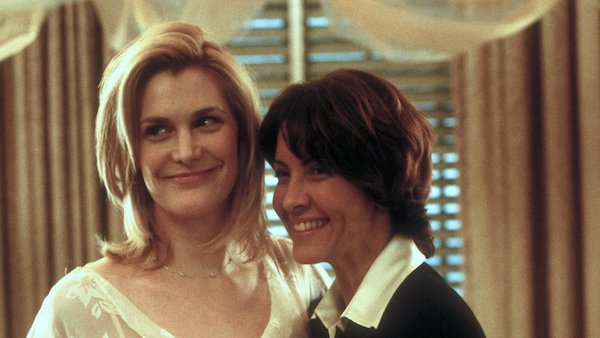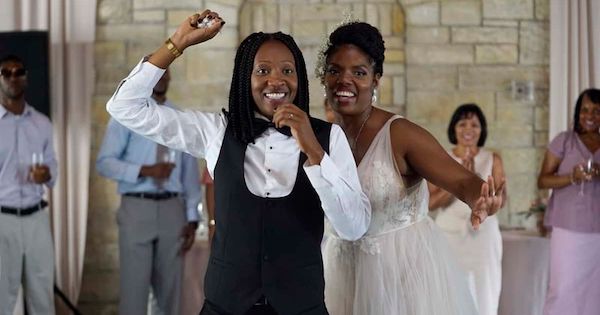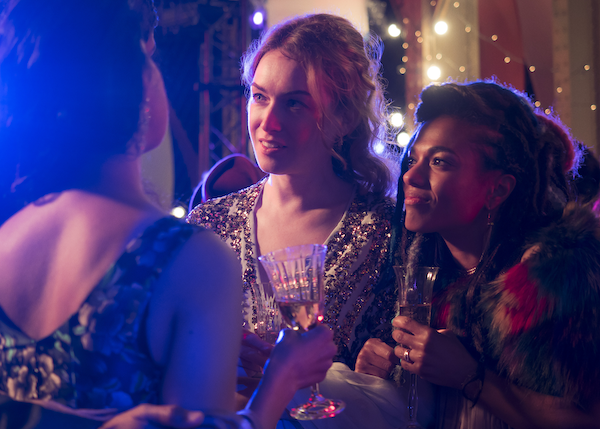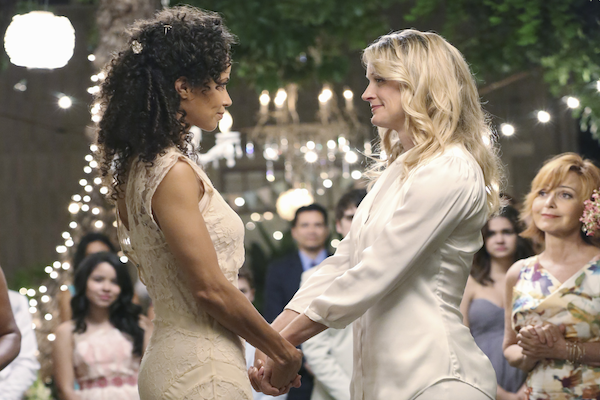This August, The L Word: Generation Q premiered its second season with a dramatic confession set at a wedding, a plot twist unfolding as two women prepared to tie the knot. Back in June, Grey’s Anatomy’s firefighter spinoff Station 19 ended its season at the wedding of two women. A recent episode of superhero dramedy Legends of Tomorrow revolved around the bisexual protagonist proposing to her girlfriend. Both favorite science-fiction/western series Wynonna Earp and critically acclaimed comedy Everything’s Gonna Be Okay ended their runs with two beloved female characters marrying one another in joyful and loving weddings.
In 2021, a queer or lesbian wedding is almost a regular occurrence on television across all platforms and genres.
This, of course, was not always the case.
January 2021 marked 25 years since the first lesbian wedding aired on American television: Friends aptly titled “The One With the Lesbian Wedding” in which Ross’s ex-wife Carol is set to marry her new partner Susan.
Though they do have the titular wedding, Carol and Susan mostly serve as a catalyst for Ross’ character development, and as joke fodder for the other friends. However, there is genuine sweetness in the wedding itself, especially in the climactic moment where Ross encourages Carol to marry the woman she loves, despite her parents’ bigotry.

When “The One with the Lesbian Wedding” aired, it was banned in several markets, prompting several advocacy groups including GLAAD to speak out against the censorship and in support of the episode. “The One with the Lesbian Wedding” showed that it was possible to break barriers by showing a lesbian wedding on an immensely popular show, while still telling the story through a straight lens.
That is the unique nuance of being the first at something – it most often is messy and imperfect, but it opens the door for more stories to be told – for there to be a second and third and a fourth.
In 2002, an episode of Queer as Folk centered around the wedding of Lindsay and Melanie. Unlike in Friends, this wedding was centered on queerness, and on the chosen family of Lindsay and Melanie who made this wedding possible. Though the episode did devote most of its screen time to the gay men on the show, the wedding itself was a display of visible love between two women, living up to the titular queerness of this groundbreaking show.
The year after Melanie and Lindsay tied the knot on Queer as Folk, Massachusetts became the first state to legalize marriage equality. But, much like the number of weddings on TV, progress was slow. The next state to follow was California five years later in May 2008, only for it to be overturned that November with Proposition 8.

Just a few months after Prop 8 was passed, in February 2009, All My Children aired the first lesbian wedding on daytime television. Though this wedding did constitute a significant first, the couple Bianca and Reese were not always the focal point of the episode, and Reese kissed a man the night before the ceremony. It presents a nuance similar to Friends – something can be a “first” and still be far from perfect.
That’s why it’s exciting that we have moved so far beyond “firsts.” In 2011, Grey’s Anatomy aired an episode centered around the wedding of Callie and Arizona. Though Grey’s is often regarded as a primetime soap opera, it did not go down the same route that All My Children did in terms of undercutting their queer love story in favor of a soapy plot twists.
The emotional climax of the Grey’s episode is remarkably similar to that of Friends. Midway through the episode, Callie’s mother decries the wedding due to her religion, leaving Callie distraught and ready to call it. Then—much as Ross convinced Carol to still marry Susan—Miranda Bailey tells Callie that their love is more powerful than anyone else’s outdated ideas. Bailey’s moving speech dismantles the idea that religion is a justifiable excuse for homophobia, saying, “your church just hasn’t caught up to God yet. Your mother just hasn’t caught up to God yet.” Due in part to that powerful speech, Callie and Arizona are able to have a joyous, loving wedding.
At this point, marriage equality laws were picking up speed around the country, and so were the storylines on television. The Fosters, a show revolving around two women raising several foster children, ended the first half of their first season with a wedding between the leads Stef and Lena. Both The Fosters and Grey’s not only showed a marriage between two women, but those women being parents, and the reality of LGBTQ couples raising children.
All of these weddings took place before it was technically legal in their respective states. Even Glee, which in typical Glee style, featured a lesbian wedding which promptly turned into a double wedding with the gay male characters – came in under the wire in February 2015, three months before the Supreme Court ruling in Obergefell v. Hodges. It’s not just a coincidence that these episodes, and the increasing LGBTQ representation on television, shifted the culture forward, and resulted in greater support for both the LGBTQ community and concrete change on a legal level.

After that ruling in June 2015, weddings between queer characters became even more frequent. The critically acclaimed episode of Black Mirror, “San Junipero” showed two women who loved each other so much they got married in a surreal version of the afterlife. Steven Universe had Ruby and Sapphire get married in a 2018 episode, showing quite literally the magic of queer love on a Kids and Family show. A 2020 episode of The Chi kicked off the season with two Black women, Nina and Dre, getting married, and included a section in the vows where Dre promised to be there for Nina’s children as well as her.
Not only were these weddings beautiful in their own right, but they also showed so many stories of queer women through the lens of their own love, not contextualized by outside forces of hatred.
One of the greatest lesbian weddings on television finishes off the two-and-a-half- hour series finale of Netflix’s Sense8. The wedding between Nomi and Amanita is a celebration of their overwhelming love and a testament to the power of human connection. And it is undeniably queer. Not only was Nomi one of the few trans lesbians on television (a still very lacking demographic on TV), but the wedding itself speaks to how the world is constantly evolving, and how we are all connected in unique ways – a hallmark of the show as whole, co-created by the Wachowskis, two trans women.
Sense8 ends with the happy couple—and several happy couples, plus a few more than couples for good measure —going back to their room. Long story short, not for the first time on Sense8, the separate people sleeping together morphs into what can only be called a supernatural connective queer orgy, with the last shot of the whole series being a close up of a rainbow strap-on.

Another wonderfully queer wedding in recent years took place on the final season of Pose, when Angel, a trans woman, married her boyfriend Lil Papi in a ceremony that emphasized the extensive chosen family of the series. The wedding made up of Black and Brown queer and trans people was both romantic and triumphant, giving happiness to Angel, who never thought she would make it to this moment.
So often, marriage is regarded as something queer folks do to fit into a heteronormative mold, but shows like Sense8 and Pose prove that queer love is something magical and powerful, and a queer wedding between doesn’t need to fit into an existing mold, it’s creating a new one that is strong and ever-evolving.
Such is the landscape of television. When “The One with the Lesbian Wedding” aired, there were only 34 LGBTQ characters on television. Now, according to GLAAD’s most recent Where We Are on TV report, there are over ten times that with 360 LGBTQ characters on broadcast, cable, and streaming. But there is still work to be done.
Showing queer love and joy on television is a political act. A quarter of a century of women marrying each other on television is a political act, and it cannot stop now. Marriage equality has been legal for six years, but LGBTQ people still do not have anti- discrimination laws in place, as The Equality Act has yet to be passed through the Senate. Anti-trans bills are being introduced at an alarming rate, and LGBTQ folks remain without federal protection in 27 states.
The same queer joy that fuels these weddings need to be applied to the most vulnerable parts of our community, showing the world that LGBTQ community is strong and powerful and isn’t going anywhere.


